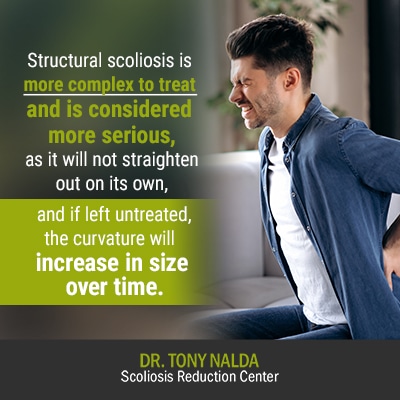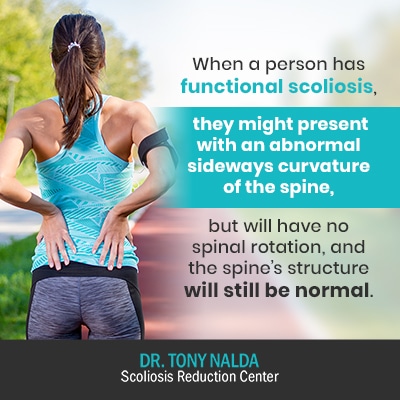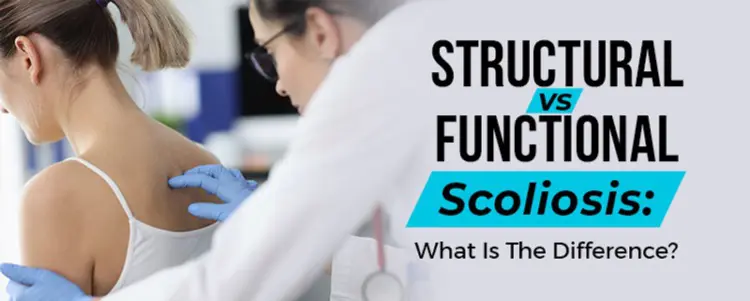In addition to the different types of scoliosis a person can develop in terms of known and unknown causes, there are also important differences between structural and functional scoliosis.
In terms of treatment, structural scoliosis is far more complex and has to be impacted on a structural level because it has a rotational element and is a true scoliosis; cases of functional scoliosis can be treated by addressing the issues that led to its development, as there are no issues with the spine’s actual structure.
The difference between structural and functional scoliosis is: STRUCTURAL SCOLIOSIS is caused by a structural abnormality within the spine, while FUNCTIONAL SCOLIOSIS is related to bad posture or other body irregularities and can be corrected by identifying and addressing the cause.
Before we move on to discussing the differences between structural and functional scoliosis, let’s talk about the different types of scoliosis a person can develop, based on their causation.
Also, here’s a video you can watch where I break down the differences in functional scoliosis and structural scoliosis:
Different Types of Scoliosis
Part of the reason scoliosis is so often described as a ‘complex and mysterious’ condition is because there is still a lot we don’t know about its most common form: idiopathic scoliosis.
‘Idiopathic’ means there is no single-known cause that accounts for its development. When it comes to scoliosis, 80 percent of known diagnosed scoliosis cases are idiopathic; the most prevalent type of scoliosis is adolescent idiopathic scoliosis (AIS), diagnosed between the ages of 10 and 18.
Idiopathic scoliosis is thought to be ‘multifactorial’, meaning its causation is attributed to multiple factors, and those factors can differ from one person to the next, rather than having one specific causative source.
The remaining 20 percent of known diagnosed cases are associated with known causes: neuromuscular, congenital, degenerative, and traumatic.
In addition, there is also structural and functional scoliosis, and they have many important differences, but first let’s address what’s happening inside the body of someone with scoliosis and why proactive treatment is so important.
The Scoliotic Spine
When someone develops scoliosis, this means their spine has an abnormal sideways spinal curvature and their spine is no longer aligned the way it should be.
A scoliotic curve bends to the side, includes rotation, has a minimum Cobb angle measurement of 10 degrees, and disrupts the biomechanics of the entire spine.
As a healthy spine is curved to give it added strength, flexibility, and enable it to evenly distribute weight and stress, a loss of these healthy curves, as an abnormal one develops, costs the spine both in terms of its overall health and function.
Scoliosis is progressive, meaning that its very nature is to worsen over time, especially if left untreated, or not treated appropriately.
As the condition’s most-prevalent form is AIS, this is the form we’ll be focusing on throughout the article, and with adolescent idiopathic scoliosis, managing progression is a big component of treatment because growth is the number-one trigger for progression; we know that adolescents going through puberty are going to face rapid and unpredictable growth spurts that could lead to rapid-phase progression.
The goal of treatment, with my adolescent idiopathic scoliosis patients, is to manage progression effectively so they never reach the higher stages of progression, don’t have to experience increasing symptoms, and can avoid the need for more invasive forms of treatment, like spinal-fusion surgery.
Spinal-fusion surgery fuses the most-tilted vertebrae of the curvature, which are multiple vertebra, together into one solid bone to eliminate movement in the area and stop progression; however, there is no guarantee that progression won’t continue, and patients are often disappointed with the loss of spinal flexibility they have to live with post-surgery.
It’s far simpler to treat a scoliotic curve while it’s still small, before it’s progressed significantly, gotten stiffer, and the body has had time to adjust to its presence. This is why proactive treatment is always the best choice, regardless of how mild a person’s scoliosis is at the time of diagnosis.
While there are never treatment guarantees, the benefits of early detection in terms of potential treatment success are significant, but those benefits are only available to those who choose to follow up that diagnosis with proactive treatment.
Now, in addition to the types of scoliosis we discussed with unknown and known causes, there are also important differences between structural and functional scoliosis to understand, so let’s move on to those.
What is Structural Scoliosis?
Structural scoliosis is the most common category of scoliosis by far. Again, in addition to the abnormal sideways curvature, there is also spinal rotation, which there is not in functional scoliosis, and this type of scoliosis affects the spine’s overall structure, function, and is considered permanent, especially if left untreated.
As mentioned, in order to fulfill the parameters needed for a structural scoliosis diagnosis, the abnormal sideways spinal curvature has to include rotation and be of a certain size: Cobb angle of 10+ degrees.
‘Cobb angle’ is a measurement obtained via X-ray that tells me how far out of alignment a scoliotic spine is. Cobb angle also places a condition on its severity scale of mild, moderate, severe, or very severe:
- Mild scoliosis: Cobb angle measurement of between 10 and 25 degrees
- Moderate scoliosis: Cobb angle measurement of between 25 and 40 degrees
- Severe scoliosis: Cobb angle measurement of 40+ degrees
- Very-severe scoliosis: Cobb angle measurement of 80+ degrees
A patient’s Cobb angle is calculated based on the amount of tilt in the vertebrae at the apex of the curve. Lines are drawn from the tops and bottoms of the most-tilted vertebrae, and the intersecting lines form an angle measured in degrees.
The higher the Cobb angle, the more severe a condition is considered, and the more tilted the vertebrae of the curvature are, disrupting the spine’s natural curvatures and alignment on a structural level.

Structural scoliosis is more complex to treat and is considered more serious, as it will not straighten out on its own, and if left untreated, the curvature will increase in size over time.
Types of Structural Scoliosis
As mentioned, there are many different types of scoliosis, and we touched on how they are classified in terms of causation; following are how the different forms fit under the ‘structural scoliosis’ umbrella.
Idiopathic Scoliosis
As mentioned, idiopathic scoliosis accounts for 80 percent of known diagnosed cases and has no single-known cause. This form is most commonly diagnosed during adolescence, but it can develop at any age, including infants and young children.
Idiopathic scoliosis in adults is the most common type of scoliosis that adults face. In adults with idiopathic scoliosis, most of these are cases of AIS that were undiagnosed and untreated in adolescence because the patients were simply unaware of their condition and progressed with it into maturity.
Most often, it’s pain that brings these adults in for a diagnosis and treatment. Adolescents with scoliosis don’t commonly find the condition painful, and particularly in mild forms, the condition isn’t known to produce many functional deficits, and even related postural changes can be too subtle for anyone, other than a specialist, to notice.
Neuromuscular Scoliosis
Neuromuscular scoliosis develops as a secondary complication of a larger neuromuscular condition such as cerebral palsy, muscular dystrophy, spina bifida, and many more.
In these types of neuromuscular conditions, there is a disconnect between the brain and the muscles and/or connective tissues that surround the spine and help provide it with support and stabilization.
This form is not typical as the underlying cause of the scoliosis, the neuromuscular condition, has to guide the treatment approach. As there is the added complication of the neuromuscular condition driving the scoliosis, I often can’t offer these patients the same level of treatment success that I can with more typical forms of the condition, although the potential to work towards improvement is there.
Degenerative Scoliosis
Degenerative scoliosis affects adults and tends to occur later in life as the spine faces degenerative changes. Spinal degeneration most commonly affects the joints and discs of the spine.
Degenerative scoliosis is also known as ‘de novo’ scoliosis, meaning the condition has developed fresh in adulthood with no prior history, as is the case with idiopathic scoliosis in adults.
After idiopathic scoliosis, degenerative scoliosis is the next most common form affecting adults.
Congenital Scoliosis
Congenital scoliosis develops in utero; infants are born with the condition. It’s caused by bone-formation issues in the spine and is relatively rare, affecting 1 in 10,000 infants.
Bone malformations include vertebrae that are more triangular in shape, rather than rectangular as they should be, or the fusing together of multiple vertebrae that fail to form into distinct and separate spinal bones.
Traumatic Scoliosis
Traumatic scoliosis is a rare form that’s caused by the spine experiencing some form of adverse trauma, such as in a car accident or fall.
In addition, traumatic scoliosis can also be caused by the presence of tumors pressing on the spine and forcing it out of alignment.
Now that we have defined structural scoliosis and addressed its different forms, let’s move on to functional scoliosis.
What is Functional Scoliosis?
Functional scoliosis, also known as ‘nonstructural scoliosis’, is far less common than structural scoliosis.

When a person has functional scoliosis, they might present with an abnormal sideways curvature of the spine, but will have no spinal rotation, and the spine’s structure will still be normal.
Therefore, functional scoliosis is caused by a temporary cause, such as chronic bad posture, or another irregularity in the body such as leg-length discrepancy (LLD).
If a person with functional scoliosis were to lay down or bend forward, the scoliotic curve would likely go away with the position change; whereas with structural scoliosis, there is no change of position that will make the curvature go away.
In cases of functional scoliosis that are caused by chronic bad posture, this can typically be treated by addressing the postural issues; exercises and stretches that encourage good posture and elongating the spine can help.
For cases of functional scoliosis caused by leg-length discrepancy, this can also be easily addressed with custom orthotics or insoles that fix the LLD, taking pressure off the spine and allowing its normal curvatures and alignment to return.
What is Functional Scoliosis?
A true scoliosis is structural, and this means that the condition’s underlying nature involves a structural abnormality within the spine itself and that there is a rotational component.
Remember, a scoliotic spine doesn’t just bend unnaturally to the side, it also twists, and this is the difference between functional scoliosis and structural scoliosis, so a patient diagnosed with functional scoliosis won’t have any spinal rotation, and the structure of the spine itself will be typical.
Structural scoliosis is progressive and incurable, while functional scoliosis is highly treatable because it’s not a permanent and progressive condition.
Diagnosing Structural vs Functional Scoliosis
When it comes to diagnosing structural scoliosis, there are certain parameters that have to be met to be considered a true scoliosis.
In fact, structural scoliosis can’t be diagnosed without the results of a comprehensive scoliosis X-ray; this involves taking a series of measurements of the spine from every angle, confirming that the scoliotic curve doesn’t just bend unnaturally, but also twists, making structural scoliosis a complex 3-dimensional condition.
In addition, a structural scoliotic curve has to be of a minimum size: Cobb angle measurement of at least 10 degrees.
Functional scoliosis can be diagnosed through a physical examination because it’s evident that when the position of the body is changed, the position of the scoliotic curve can also be changed, and this is the main difference between structural versus functional scoliosis.
A diagnosis of functional scoliosis is easier to give than structural scoliosis because as a non-structural condition, it can be addressed without the need of intense chiropractic treatment and/or surgical intervention.
How to Fix Functional Scoliosis
Functional scoliosis is postural, not structural, and this means that the spine’s unnatural curve will be affected by a change in position; when a condition is structural, no change in position can alter the spine’s alignment.
When it comes to fixing functional scoliosis, this generally involves first determining the underlying cause of the unnatural spinal curve, and as the cause of functional scoliosis is temporary, it is simpler to treat that structural scoliosis.
Functional scoliosis can be caused by chronic poor posture or a body irregularity such as leg-length discrepancy (LLD).
When poor posture is determined as the cause, treatment focuses on how to improve the patient’s posture, and this commonly involves scoliosis-specific exercises and stretches that facilitate healthy posture and elongate the spine.
When leg-length discrepancy is determined as the cause of a patient’s functional scoliosis, the irregular leg length has to be addressed, and this commonly involves the prescription of custom orthotics or insoles that equalize leg length, taking pressure off the spine and facilitating the return of the spine’s natural curves and alignment.
Scoliosis is an asymmetrical condition that introduces a lot of uneven forces to the body, and as such, it’s also vulnerable to other conditions/issues that disrupt the body’s overall symmetry.
Chronic poor posture can be a contributing factor in the development of a number of spinal conditions/issues because it introduces uneven forces and adverse spinal tension that, over time, can actually affect the position of the spine’s vertebrae (bones) and alignment, as it the case with functional scoliosis.
Conclusion
When it comes to the main difference between structural and functional scoliosis, we are talking about structural issues within the spine that are permanent, versus a likely temporary spinal curvature, with no rotation, that can be caused by bad posture or another irregularity in the body, such as leg-length discrepancy.
True scoliosis is structural and involves rotation, which is why it’s so important to seek out proactive treatment to work towards addressing the conditions’s underlying structural nature.
As scoliosis is progressive, steps have to be taken to try and stay ahead of a patient’s progressive line as it’s far simpler to treat a small curvature while it’s still small, rather than after it has been left to progress unimpeded.
With functional scoliosis, this is a condition that also presents as an abnormal spinal curvature, but the curvature is not structural in nature, meaning that it is a temporary curvature that can be easily addressed with changes to position, posture, or addressing other body irregularities causing the curvature.
Here at the Scoliosis Reduction Center®, I combine multiple scoliosis-specific treatment disciplines such as chiropractic care, in-office therapy, custom-prescribed home exercises, and ultra-corrective bracing to impact my patients’ scoliosis on a structural level.
I apportion these disciplines accordingly to address the specifics of each patient and their condition. As the very nature of scoliosis necessitates an integrative and customized treatment approach, I use these different facets of treatment to impact the spine in terms of stabilization, increasing core strength, and achieving a curvature reduction.





